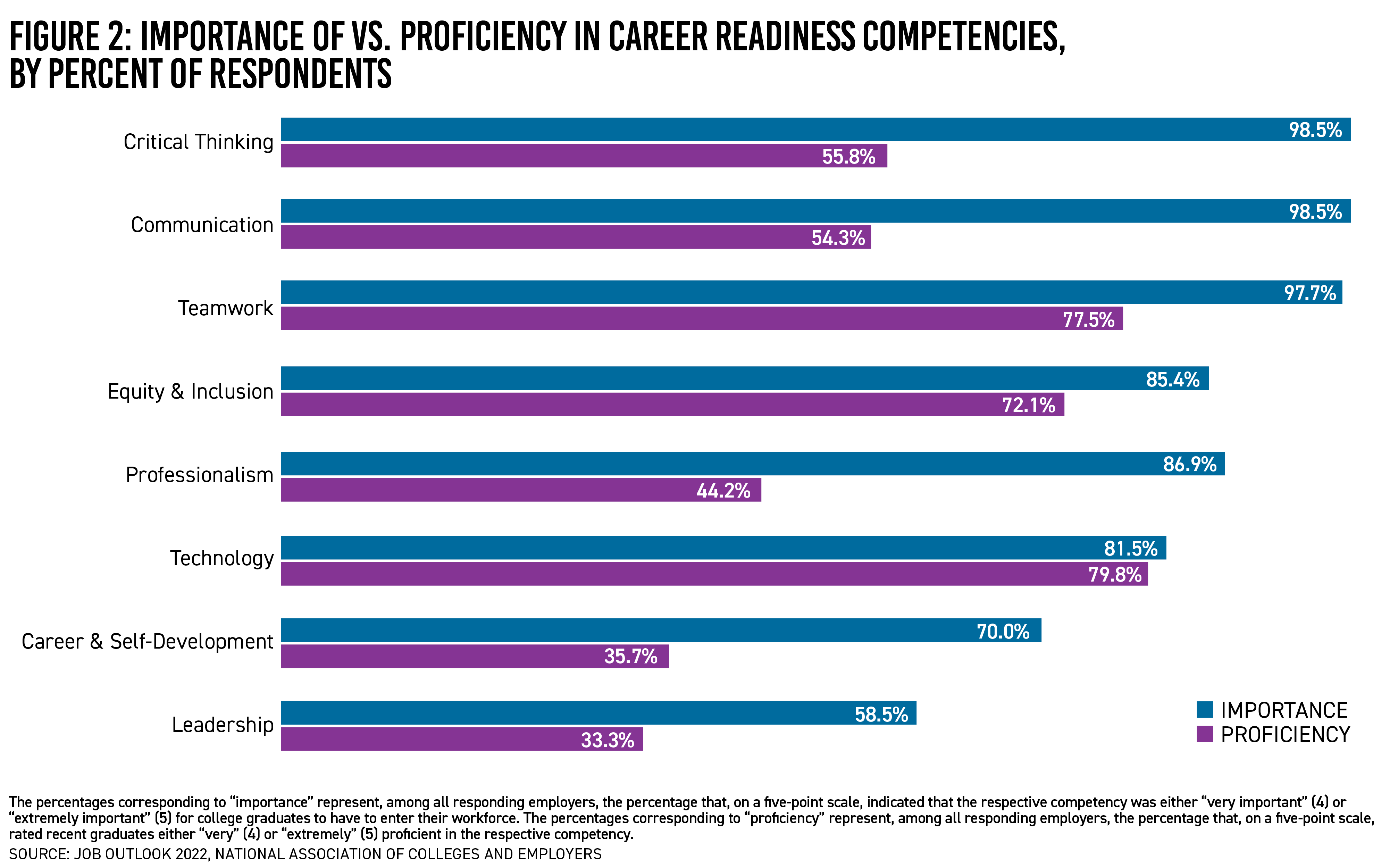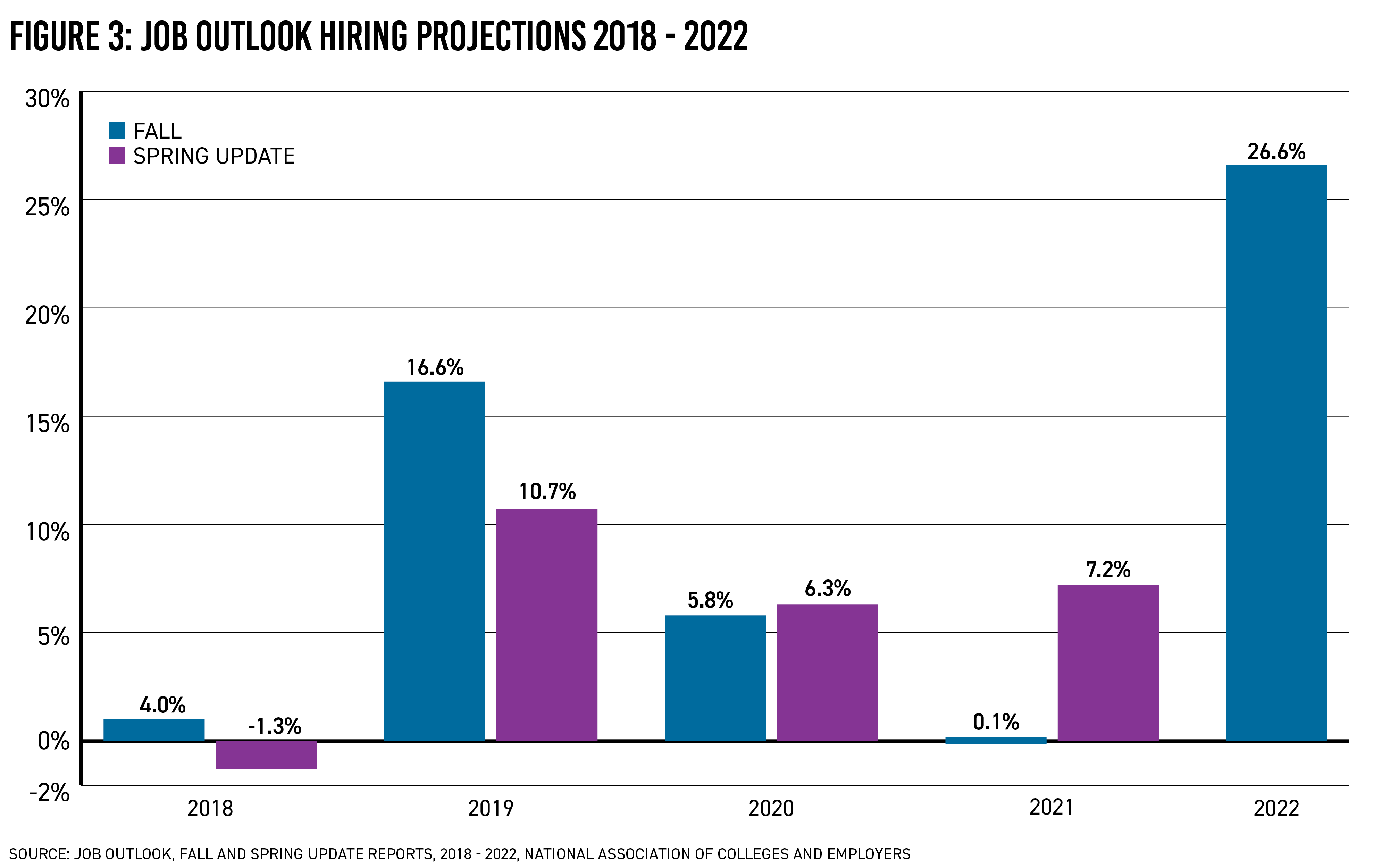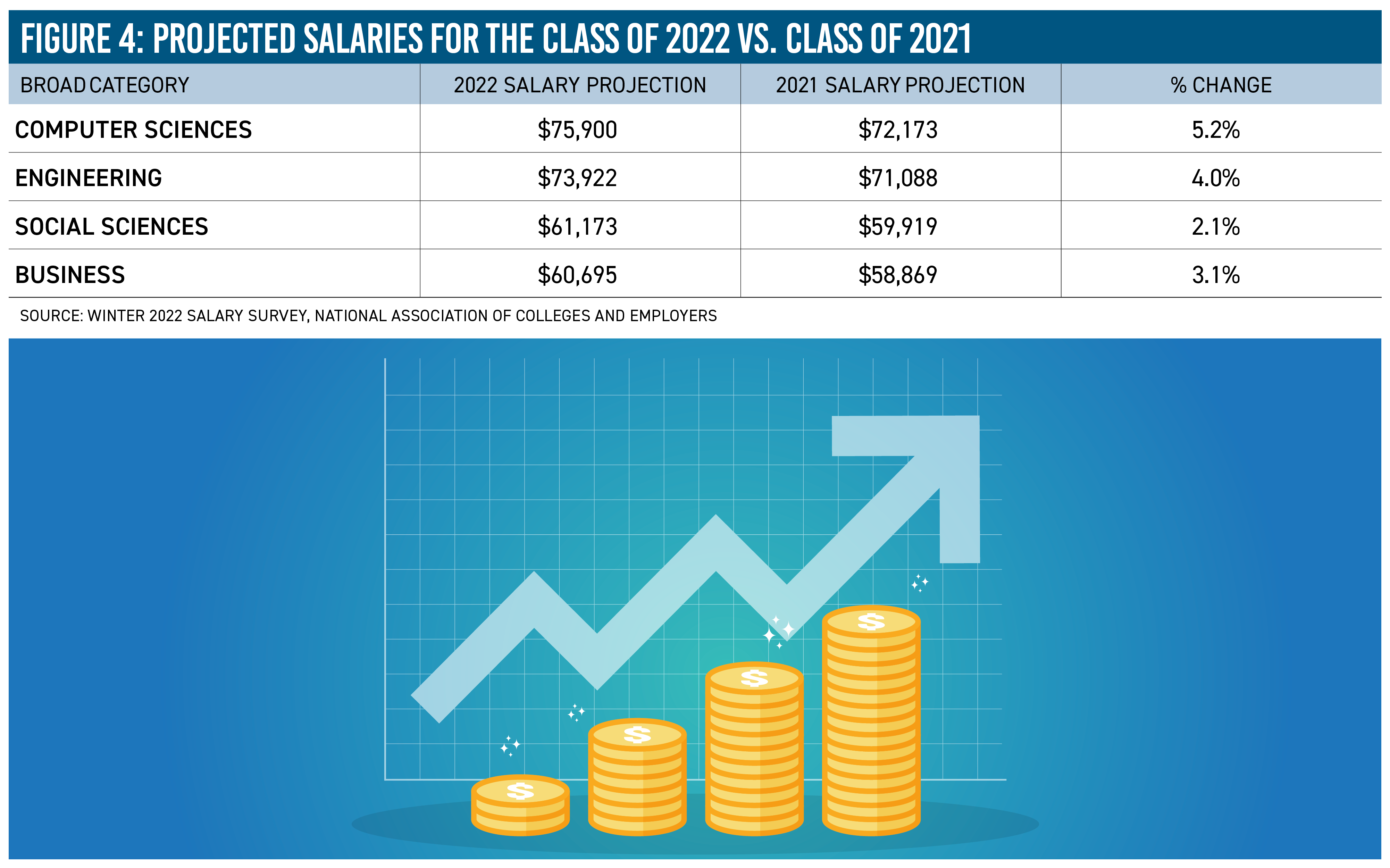NACE Journal, February 2022
To be sure, there has been a tremendous amount of disruption to our professional lives over the past three years. With that, however, have come opportunities to redefine who we are and how—and where—we operate.
The flexibility, problem-solving, nimbleness, innovation, and other qualities we continue to demonstrate are solid evidence of the very competencies that we, as an association, have identified as crucial to our work in developing college students. This is undeniable evidence of their importance at both the start of and throughout our careers.
Career Readiness: Foundation and Future
While many of the shifts we have experienced have been seismic, our foundation has endured.
For example, our research, work, and interactions continue to tell us that career readiness is the key to ensuring new college graduates successfully enter the workforce. It’s no coincidence that the top three attributes employers indicate they are seeking on student resumes this year are in lockstep with the competencies: problem-solving skills, analytical/quantitative skills, and the ability to work as part of a team.1 (See Figure 1.)

Career services professionals should continue to help their students develop these soft skills and reflect on how they have put them into practice, and advise them to put these skills front and center on their resumes. They can also help their students stand out and prepare for a successful transition to the workforce by providing programming and resources to help boost their proficiency in critical thinking, communication, and professionalism. NACE research found that these career readiness competencies have the biggest gaps between employer perceptions of importance and student proficiency.2 (See Figure 2.)

Promising Practices for Competency Development: What Can Be Done
Higher Education Professionals- Create competency steering committees;
- Offer academic and teaching innovation centers;
- Coordinate competency development with student activities and leadership experiences;
- Incorporate competency development with work-study programs;
- Develop badging initiatives;
- Offer internship courses (credit/noncredit);
- Provide capstone courses; and
- Develop assessment plans to measure the impact on outcomes and institutional effectiveness.
Employers
- Infuse competencies into interviews;
- Map competencies to career pathing;
- Integrate competencies into internship and co-op programs;
- Embed competencies into job descriptions; and
- Write competencies into goals and performance reviews.
On a larger scale, career center leaders and staff should focus on and advocate for integrating skills and competency work into all aspects of the higher education ecosystem. Weaving career competencies throughout curriculum, co-curricular activities, work-study programs, and more will help students meet the demands of employers and prepare college graduates for success in the workplace and lifelong career management.
Likewise, employers should stress their desire to hire candidates who are adept in the career readiness competencies and then support this by identifying competencies in job descriptions and during interview preparation. Employers should also incorporate competency development into their programming, including their internship and co-op programs. (See “Promising Practices” for more information about competency development.)
Recruiting in a Tight Job Market
It is important to prime students to take advantage of the career opportunities available to them in the current robust job market. With job openings exceeding 10 million and the unemployment rate hovering around 4%, employers are experiencing a very competitive labor market.3, 4
In our specific arena, employers plan to hire 26.6% more new college graduates from the Class of 2022 than they did from the Class of 2021. (See Figure 3.) Not only is hiring up, but, in many areas, salaries are also expected to rise. (See Figure 4.)


Organizations that maximize their recruiting efforts in the current market will master virtual recruiting. That is, they will not be reactive to shifts, but they will anticipate them and innovate so they are on the leading edge in connecting with, supporting, developing, attracting, and hiring top talent. Furthermore, doing so can be a critical tool for strengthening diversity recruiting efforts.
Diversity, Equity, and Inclusion in Recruiting and Hiring
For most organizations, building an inclusive workforce is a key goal. In fact, our most recent recruiting benchmarks survey found that nearly 89% of responding employers have formal diversity recruiting efforts in place. That has increased by more than 30% since 2016, as more organizations look to make stronger, more meaningful commitments to diversity, equity, and inclusion (DEI).5
In support of that goal, NACE has begun investigating recruiting issues through a DEI lens to identify possible barriers and opportunities. Based on the data we have gathered thus far, we have also developed a series of recommendations to help organizations identify and address problems.
One interesting—and actionable—takeaway from our recent research involves virtual recruiting. Our research indicates that virtual recruiting provides a better job-search experience for historically marginalized populations than in-person recruiting, making it a viable tool for employers that want to develop a wider, more diverse pool of candidates.6
Results from NACE’s 2021 Student Survey found that, overall, Black, Hispanic, female, and first-generation college students believed they learned more, got a more authentic view of the potential employer, and had better interactions with employer representatives in the virtual world than during in-person encounters.
We will stay on top of trends in virtual recruiting to determine if the positive response we’re seeing from historically marginalized student populations continues once the pandemic subsides and in-person interaction becomes a more viable option. However, it is important to recognize that virtual recruiting can play a meaningful role in helping employers build an inclusive pool by effectively eliminating geographic barriers.
Addressing inequity in paid internships
Virtual recruiting may also help employers address other obstacles to an inclusive workforce, including inequities in paid internships. Women, communities of color, and first-generation students continue to be underrepresented in paid internships, which is often the entry point to the job market, giving students who secure them a head start on their career path. Because of these inequities, underrepresented students are not getting the same career start, which feeds the cycle of inequity.7
Virtual recruiting may provide a means for employers to develop a wider, more inclusive pool of candidates for internships, but there are several initial steps employers can take to identify if and where problem areas exist, including:
- Auditing the historical makeup of their internship pool to get a baseline on intern demographics;
- Tracking applicants to determine where there is underrepresentation;
- Assessing how intern talent is sourced and adjusting to identify additional sources; and
- Reviewing recruiting and hiring processes to identify barriers that hinder diverse talent from engaging with the organization.
Pay inequity: The gender gap
Another equity issue that we are tracking is the gap in pay by gender.
According to the U.S. Bureau of Labor Statistics, overall, women earn approximately 82% of what their male counterparts earn. NACE research reveals that this gap begins as graduates exit college for the world of work.8 Because this differential exists from the very start of their careers, common myths—that the gender pay gap results from women prioritizing family over career and thus begins later and, in part, that differences in academic majors explain the pay gap—can be dispelled.
Organizations must correct this inequity. Here’s how employers can start:
- Standardize pay and eliminate the discretion to set salaries for new hires. Much has been said about women not being as good at negotiating salaries as men. There are two major issues with that position. First, it’s a misdirection from the real point: Salaries should be based on nonsubjective criteria, such as responsibilities, qualifications, and experience, not on one’s ability to influence another. Second, negotiating ability can only be judged by the individual on the receiving end. If that person has a bias, whether overt or unconscious, then the result is inevitably biased. Justifying salary differentials on the basis of negotiating skills is a convenient way to explain away discrimination based on gender.
- Conduct an annual pay equity analysis to determine if there are differentials on the basis of gender and race/ethnicity. In such reviews, any salary differential discovered correlated with gender or race/ethnicity must be challenged for cause. If no legitimate work-related cause (workload, performance) can be uncovered, then the differential must be corrected immediately.
*****
To be sure, our profession is doing good work and driving the makeup and proficiency of our country’s workforce in a positive direction. We all have a part to play to ensure that our world is more equitable, and we will because we are a dynamic, collaborative profession that, even in the face of a worldwide pandemic, creates intentional and innovative ways to convert awareness into action.
Resources for Strategic Planning and Positioning
Environment Scan for 2021-22: Designed to inform strategic thinking, this working document focuses on demographics (current as well as projected) that will drive change in higher education, business and industry, and the labor force and offers insights on the economy, college labor market, and talent acquisition. Free. www.naceweb.org/talent-acquisition/trends-and-predictions/environmental-scan/.
Job Outlook 2022: The report not only provides hiring projections for the Class of 2022 but also examines employers and how they view and select candidates, their view of the job market, and other employment-related issues. Free to NACE members. www.naceweb.org/store/2021/job-outlook-2022/ .
NACE Brief: Gender and Pay Inequity: Gleaned from results of the college Class of 2020 First-Destination Survey, the brief looks at starting salaries for new college graduates by gender and provides steps for correcting inequity. Free. www.naceweb.org/job-market/graduate-outcomes/first-destination/class-of-2020/.
NACE Brief: Inequity in Internships: Based on results from NACE’s 2021 Student Survey, this brief looks at the roles that race/ethnicity and gender play in paid internships. Free to NACE members. www.naceweb.org/research/reports/2021-nace-student-survey-briefs-4-year/.
NACE Brief: Virtual Recruiting: Based on results from NACE’s 2021 Student Survey, this brief examines student attitudes about virtual recruiting based on race/ethnicity. Free to NACE members. www.naceweb.org/research/reports/2021-nace-student-survey-briefs-4-year/.
NACE 2021 Student Survey: The annual survey examines student attitudes and actions related to employers and employment. Free to participating members. www.naceweb.org/research/reports/2021-nace-student-survey-product-suite/
NACE 2021 Recruiting Benchmarks Survey Report: www.naceweb.org/store.aspx. Free to participating members.
Endnotes
1 Job Outlook 2022 (November 2021). National Association of Colleges and Employers.
2 Ibid.
3 Job Openings and Labor Turnover – December 2021 (February 1, 2022). Bureau of Labor Statistics, U.S. Department of Labor. Retrieved from www.bls.gov/news.release/pdf/jolts.pdf.
4 The Employment Situation – December 2021 (January 7, 2022). Bureau of Labor Statistics, U.S. Department of Labor. Retrieved from https://www.bls.gov/news.release/pdf/empsit.pdf.
5 NACE 2021 Recruiting Benchmarks Survey Report (February 2022). National Association of Colleges and Employers.
6 Collins, M. (October 29, 2021). Virtual Recruiting Offers Path to Equity in Hiring for Full-Time Jobs and Internships, Spotlight. Retrieved from www.naceweb.org/talent-acquisition/student-attitudes/virtual-recruiting-offers-path-to-equity-in-hiring-for-full-time-jobs-and-internships/.
7 Ibid.
8 NACE Brief: Gender and Pay Inequity (December 2021). National Association of Colleges and Employers. Retrieved from www.naceweb.org/job-market/graduate-outcomes/first-destination/class-of-2020/.






